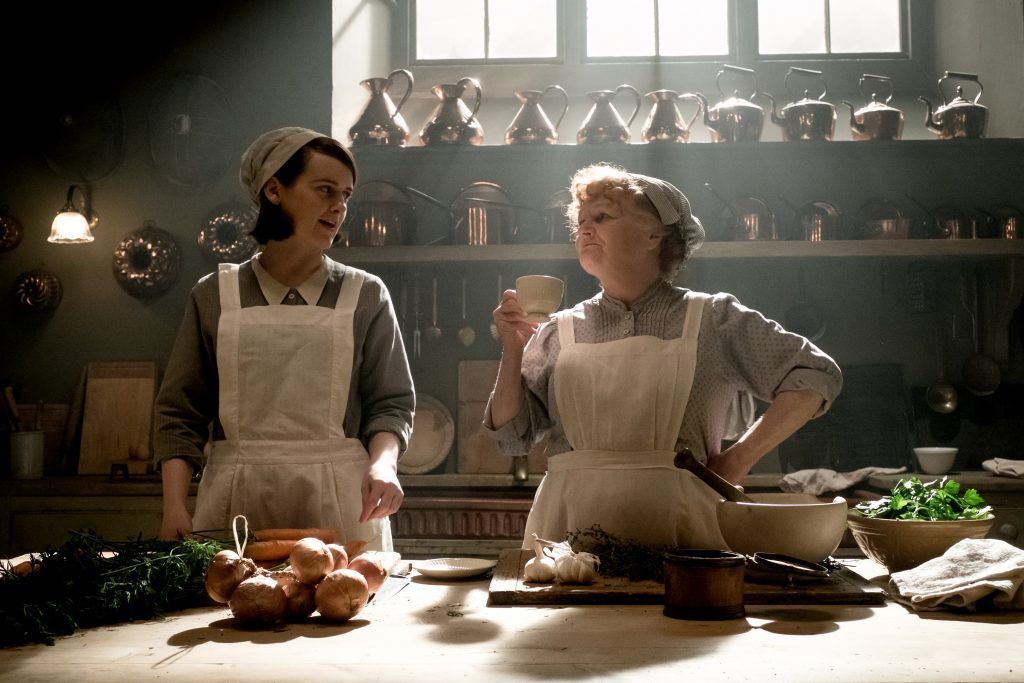
When “Downton Abbey” hit the big screen, hungry fans lined up for tickets to satisfy their cravings for another look at the Edwardian-era saga of aristocrats and servants.
As usual, the story presented in the film is multi-layered, revolving around one unifying event, a royal visit and dinner for King George V and Queen Mary. An event, which actually took place in 1917 at Highclere Castle, the location of the fictional Downton Abbey.
With the royals’ pending arrival, Downton’s cook, Mrs. Patmore, played by Lesley Nicol, scans her cookbooks to find the perfect receipts (recipes) to prepare a feast that will make Downton’s Lord and Lady Crawley proud.
“When the king and queen come to visit Downton, it’s a big deal, and everyone’s really excited,” Nicol said, while outlining the script. “Patmore is beside herself, because she thinks she’s going to be able to do a royal luncheon, a parade and an evening dinner. When she is told that she’s surplus to requirements (not needed), it’s devastating. The servants are being usurped, even Mrs. Hughes is being replaced, by the royal staff. They’re all slightly flummoxed about this, so they cook up a little plan to derail that situation – it’s very good!”

The staff manages to get the king’s cook and the royal staff out of the way. Mrs. Patmore, with the help of Daisy and the downstairs staff, pulls off a dinner of regal splendor. And let’s not forget teas, luncheons and miscellaneous meals the camera catches throughout the film, with foods that have been painstakingly researched by food historians and presented beautifully by food stylists who filled each plate, tray and glass with period-correct foods and libations.
Watch for those scenes closely, and you’ll become hungry for the taste of the past, for the recipes popular back in the day when those in England and across the pond here in the U.S. experienced Gilded Age dining. These are recipes for both the upstairs and downstairs tables, such as those found in the recently published “Official Downton Abbey Cookbook” by Annie Gray, and in “The Gilded Table (campbellhousemuseum.org)” by yours truly, Suzanne Corbett. Within the pages of each book are recipes that will enable one to dine like a king, or at least as a member of the social elite.
“Downton Abbey” is currently in theaters. Catch it before it leaves. And for the hardcore “Downton” fan whose budget won’t allow a trip to Highclere Castle, consider a visit to St. Louis’ own gilded table at the Campbell House Museum. Look for the unique lighting fixture in the dining room near the Campbell sideboard. It’s a piece much like the one that also decorates Highclere Castle and is often seen in the series and the film.
To celebrate the film, I recommend indulging in a couple of fashionable sweet treats of the era, each worthy of the Downton Abbey table and fit for a king.
The following recipes are from “The Gilded Table,” courtesy of The Campbell House Museum.

Blancmange
1 cup half-and-half
1 envelope unflavored gelatin
1 cup sugar
1 cup sugar
1 teaspoon rose water or vanilla
1 tablespoon almond extract or brandy
1/2 teaspoon cinnamon
Place half-and-half in a small bowl. Add gelatin and stir until dissolved. Set aside.
In the top of a 1 1/2-quart double-boiler, combine the milk and sugar. Place over a medium heat, and stir until sugar has dissolved. Stir in cream and gelatin mixture, and gently heat through. Remove from heat. Stir in flavorings and cinnamon; then strain into a bowl. Pour mixture into four to six small ramekins or molds. Chill until firm. When ready to serve, remove from the refrigerator, and unmold each blancmange by dipping bottoms of each mold in a bowl of warm water and running a tip of a knife around the edge. Place a dessert plate on top of mold and flip over. Serve plain or garish with fresh or candied fruit.
Charlotte Russe
4 egg yolks
1/2 cup sugar
1 cup whole milk
1 envelope unflavored gelatin
2 tablespoons cold water
1 tablespoon orange flower water or 2 teaspoons vanilla
1 cup heavy cream (40% butterfat)
Lady fingers (sponge cakes)
Split lady fingers in half and place rounded side down to cover the bottom and sides of a 4-quart springform pan. In a 2 1/2-quart double-boiler, whisk together egg yolks and sugar. Whisk in milk. Place over a medium heat to keep water in bottom half of the double-boiler simmering. Cook until mixture thickens to a custard. Dissolve gelatin in the cold water; then whisk into custard. Cool custard, but do not allow it set. Once custard is cooled to room temperature, fold in orange flower water. Whip cream until stiff and fold into custard. Pour into lady finger-lined spring-form pan, smoothing out the top of custard. Refrigerate until custard firmly sets. Garnish with fresh or candied fruits and/or Chantilly whipped cream. Makes six servings.





